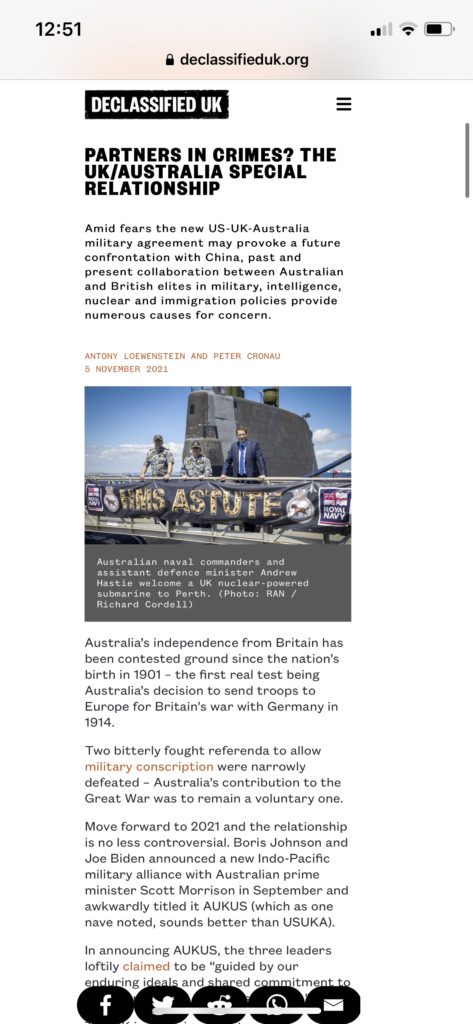The recent launch of Declassified Australia coincides with the first piece by journalist Peter Cronau and me for the great news organisation Declassified UK on the often sordid and secretive relationship between Australia and the UK.
Some highlights (but read the whole thing):
Australia’s independence from Britain has been contested ground since the nation’s birth in 1901 – the first real test being Australia’s decision to send troops to Europe for Britain’s war with Germany in 1914.
Two bitterly fought referenda to allow military conscription were narrowly defeated – Australia’s contribution to the Great War was to remain a voluntary one.
Move forward to 2021 and the relationship is no less controversial. Boris Johnson and Joe Biden announced a new Indo-Pacific military alliance with Australian prime minister Scott Morrison in September and awkwardly titled it AUKUS (which as one nave noted, sounds better than USUKA).
In announcing AUKUS, the three leaders loftily claimed to be “guided by our enduring ideals and shared commitment to the international rules-based order”.
The UK in July signalled its re-emergence as a Pacific Ocean force when it announced the aircraft carrier HMS Queen Elizabeth would lead a fleet of UK navy ships to join with the US Navy in leading a flotilla of warships including Australian and Japanese vessels through the South China Sea.
The Australian Defence Department would neither confirm nor deny the precise nature of the maritime exercise. However on this occasion the fleet kept a wary distance from Chinese-claimed territory.
The US may brandish the world’s most powerful military but it is turning towards its traditional friends as it readies for confrontation, and perhaps conflict, with the rising economic and military powerhouse of China.
…
However, it is the top secret Pine Gap satellite surveillance base – officially titled ‘Joint Defence Facility Pine Gap’ (JDFPG, but known generally to the 800 staff as ‘the base’) – that is Australia’s greatest contribution to the Five Eyes alliance that also includes Canada and New Zealand.
Located near Alice Springs, it’s a base for the CIA, National Security Agency and National Reconnaissance Office and collects signals and other data from an array of satellites snooping on military, commercial and private communication systems.
Mirrored with the NSA’s base at RAF Menwith Hill in North Yorkshire, it forms a global surveillance net.
Battlefield intelligence used by the US in its ‘war on terror’ has been gathered and analysed at Pine Gap for use by the US military including in potentially illegal drone strikes in the Middle East that have killed thousands of civilians.
…
The UK and Australia have played a key partnership role since the 9/11 attacks but have dealt with the fallout slightly differently. When the Brereton Report, an Australian-government led investigation into alleged war crimes by Australian special forces in Afghanistan, released its findings in November 2020 the results were devastating.
A four-year inquiry found that 39 Afghan civilians were murdered by Australian forces in 23 incidents in 2009, 2012 and 2013. The Kabul-based Australian photojournalist Andrew Quilty uncovered countless more killings by Australian soldiers that went unmentioned in the Brereton Report.
According to the Australian government, the Taliban takeover of Afghanistan may potentially hinder ongoing investigations into war crimes though the country is at its most relatively peaceful for decades. It’s hard not to conclude that Australian officials view the Taliban government as a convenient impediment to progressing with any prosecutions.
…
It’s the militarised immigration policy where Canberra arguably inspires London the most. Australia’s immigration policy is known for its brutal disregard for human rights and sending refugees to remote Pacific Islands for processing. The policy hasdeep roots in Australia’s settler colonial history.
The so-called Pacific Solution began in 2001 and quickly received bi-partisan support in the Federal Parliament. Forcibly placing vulnerable refugees from Afghanistan, Iraq, Syria, Myanmar, Sri Lanka or elsewhere in overcrowded, hot and dangerous locations was a cruelly effective method of dehumanising and silencing people, many of whom were escaping wars in countries that Australia was supposedly trying to liberate through occupation.
Despite protests from the European Union and many other liberals around the world, Australia’s refugee policy has become a model for the EU and Britain under the Conservative government.

